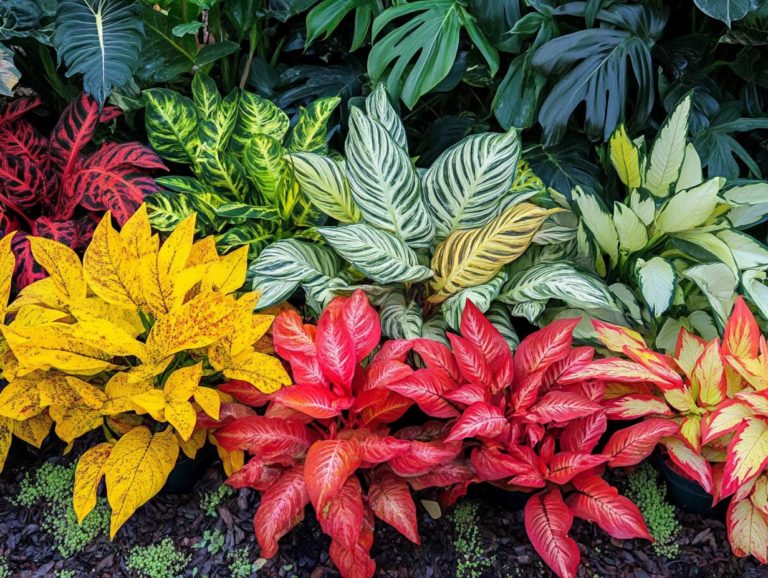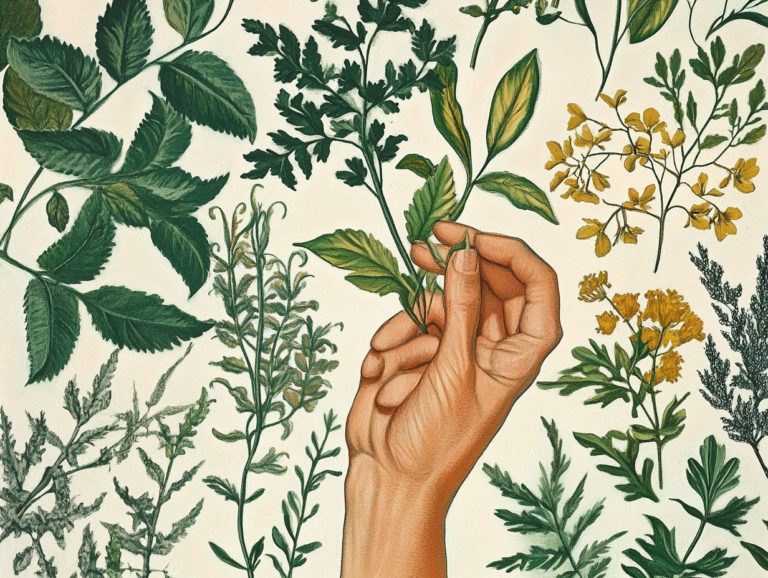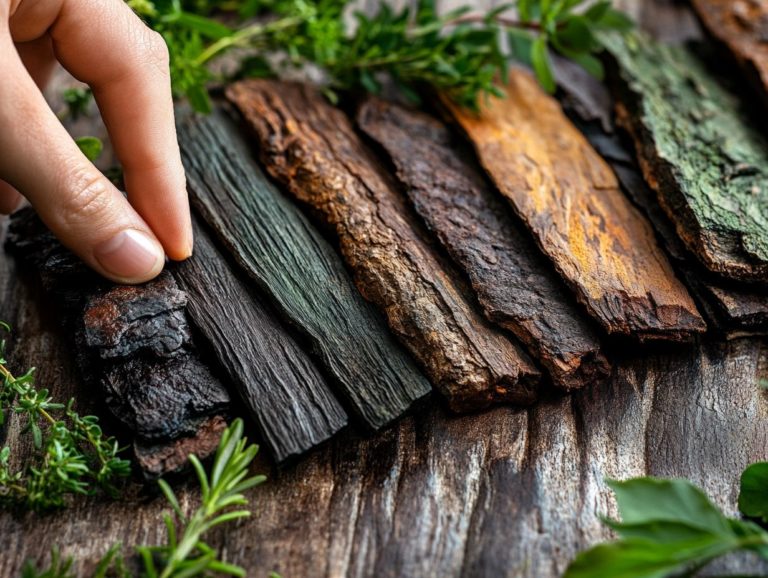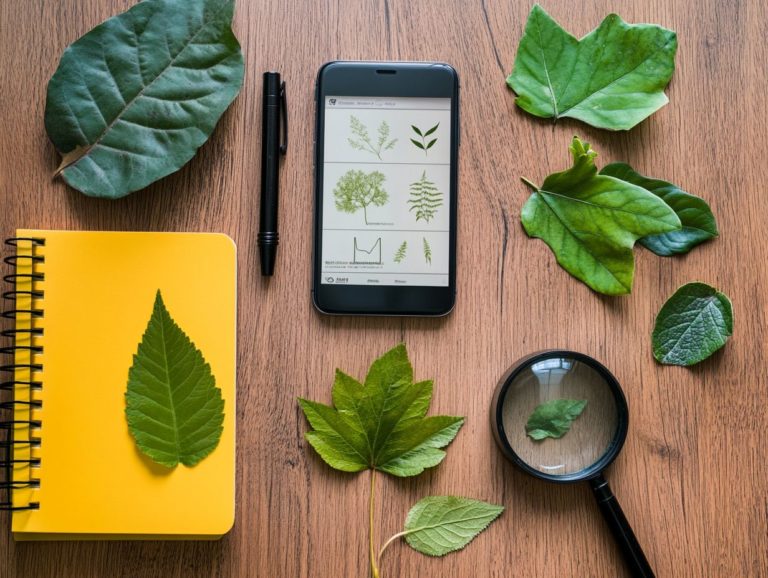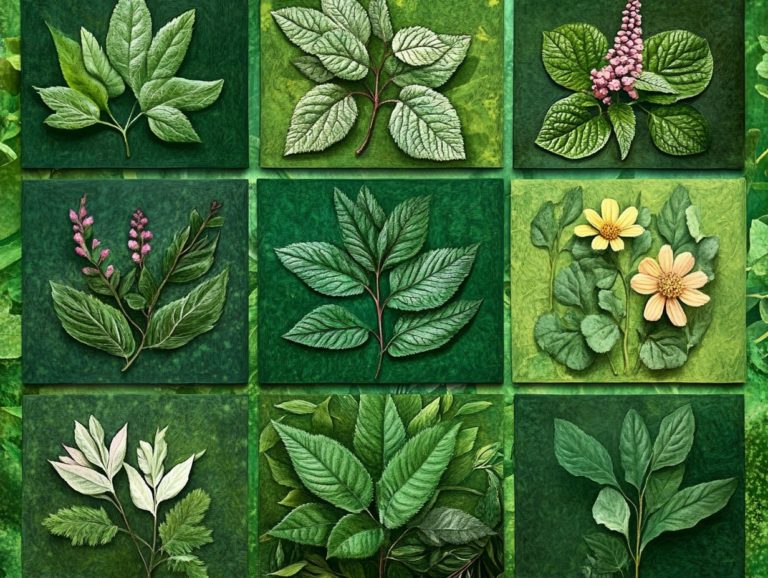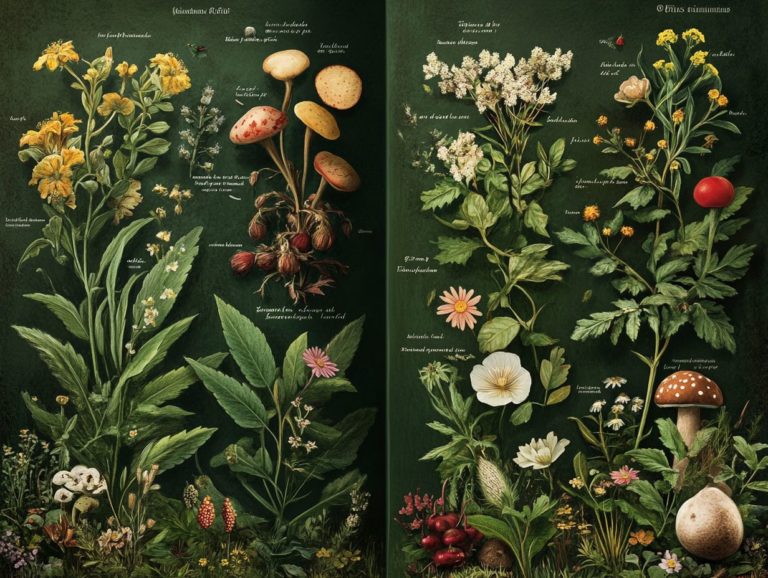Wild Edibles: A Guide to Leaf Shapes
Exploring the world of wild edibles reveals a treasure trove of flavors and nutrients just beyond your doorstep.
Dandelions and wild garlic are just a few examples of plants that can enhance your diet and offer amazing health benefits.
You’ll learn to identify these plants by their unique leaf shapes. You’ll also discover common wild edibles, their nutritional values, and important safety tips for foraging.
Join this adventure and unlock the wonders of nature’s pantry!
Contents
- Key Takeaways:
- What are Wild Edibles?
- Identifying Wild Edibles by Leaf Shapes
- Simple Leaf Shapes
- Compound Leaf Shapes
- Leaf Arrangements: Alternate and Opposite
- Common Wild Edibles and Their Leaf Shapes
- Safety Considerations When Foraging for Wild Edibles
- Frequently Asked Questions
- What is the purpose of a leaf shape guide for wild edibles?
- How can I use a leaf shape guide to identify wild edibles?
- Are there any specific leaf shapes that are common among edible plants?
- Can leaf shapes change or vary within the same plant species?
- What are some common leaf shapes that are found in poisonous plants?
- Is a leaf shape guide the only tool I need to properly identify wild edibles?
Key Takeaways:
- Boost your nutrition by adding wild edibles to your diet, which increases your nutrient intake and adds variety.
- Learn to identify leaf shapes to safely forage for wild edibles. Recognizing simple and compound shapes as well as leaf arrangements helps you tell edible plants from poisonous ones.
- Stay safe while foraging by knowing the right identification techniques and preparation methods to avoid harmful plants.
What are Wild Edibles?
Wild edibles are healthy foods you can find around you. These plants are invaluable in survival situations, providing vital resources for those skilled in gathering food from nature.
To eat them safely, it’s essential to use an identification guide. The Army field manual FM 21-76 details many edible plants.
Cooking with ingredients like wild potato, Solomon’s-seal, and water chestnut enriches your meals and helps you appreciate nature’s abundance.
Benefits of Incorporating Wild Edibles into Your Diet
Adding wild edibles to your meals can enhance your nutrition and support food sustainability. These plants often contain higher levels of vitamins and minerals than cultivated varieties.
For example, the wild leek is rich in vitamin C and antioxidants, showcasing nature’s ability to nourish. Dandelion root is known for supporting liver health, while elderberries are packed with vitamins A and C for a strong immune system.
By foraging for these plants, you diversify your meals while contributing to a sustainable food system. This practice connects you to local ecosystems and fosters a sense of responsibility for preserving natural resources.
Identifying Wild Edibles by Leaf Shapes
Recognizing wild edibles by their leaf shapes is a key skill for any forager. This knowledge is crucial for effective identification.
Understanding various leaf structures sharpens your foraging skills. It helps you tell apart edible leaves from harmful ones, ensuring safe incorporation of wild plants into your meals.
Simple Leaf Shapes
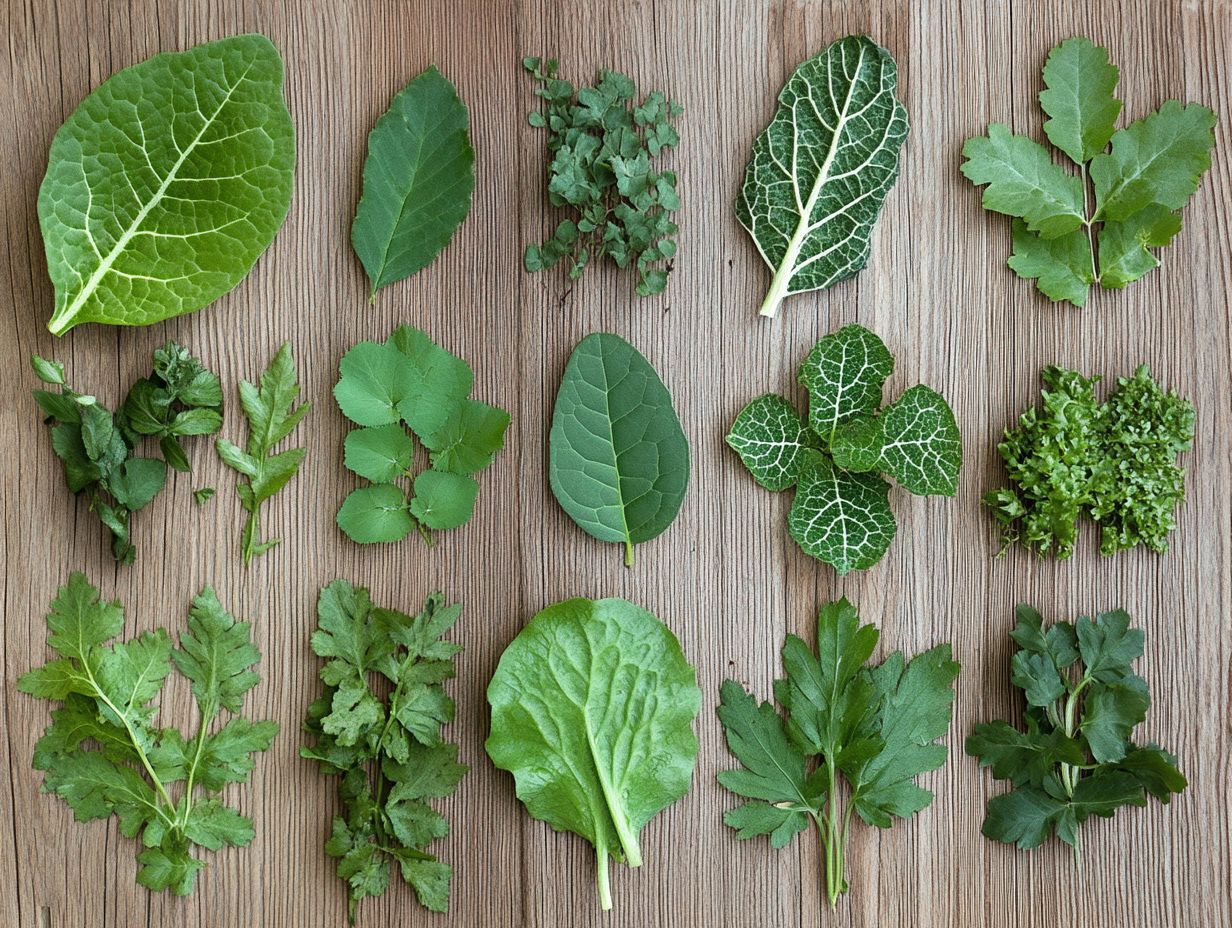
Simple leaf shapes are among the easiest to identify in the wild. Many edible leaves, like those from the wild onion and the Ti plant, fit this category, making them accessible for beginners in foraging.
An effective identification guide provides visual references and descriptions to help you distinguish these beneficial plants from their look-alikes.
Identifying these leaves is simple when you focus on their unique features. For instance, wild onion has long, slender leaves with a sharp aroma, which serves as a helpful clue during identification. The Ti plant also stands out with its broad, paddle-shaped leaves.
As you forage, pay attention to features like leaf color and texture. Observing the growth patterns of these plants can enhance your ability to recognize and safely harvest these edible greens, ensuring a rewarding experience outdoors.
Compound Leaf Shapes
Compound leaf shapes, characterized by multiple leaflets attached to a single stem, present unique identification challenges and rewarding opportunities for foragers. Certain wild edible plants with compound leaves, such as bulrush and mescal, provide nutritious options for those skilled at recognizing safe wild food.
Take, for instance, the broadleaf arrowhead, which has arrow-shaped leaflets commonly found near water bodies. This delightful plant can elevate your salads thanks to its impressive vitamin content. Then there s the staghorn sumac, with its feathery leaves that make refreshing drinks loaded with antioxidants, substances that help protect your cells.
By understanding the growth patterns and seasonal changes of these plants, you can enhance your foraging skills. Each plant not only enriches your diet but also emphasizes the importance of proper identification in your quest for edible leaves.
Leaf Arrangements: Alternate and Opposite
The arrangement of leaves on a stem whether they alternate or appear opposite is a vital clue in identifying wild edibles. This detail helps distinguish various species, including those with delectable leaves like flowering rush and edible ferns.
Understanding the differences between alternate and opposite leaf arrangements is crucial for anyone exploring foraging. For example, purslane showcases an alternate leaf pattern, where its leaves spiral around the stem. In contrast, mint has an opposite arrangement, with leaves emerging in pairs from either side.
As you forage, observe unique traits like leaf shape and arrangement. Alternate leaves have a singular structure, while opposite leaves sit snugly together. Purslane isn’t just tasty; it’s also packed with omega-3 fatty acids. Mint adds flavor to various dishes, making both plants worthy additions to your wild edible collection.
Common Wild Edibles and Their Leaf Shapes
Understanding the intricacies of leaf shapes among common wild edibles can elevate your foraging experience while ensuring safe consumption. Many wild edible plants exhibit unique shapes that aid in identification and hint at their health benefits.
Consider the water chestnut with its distinctive foliage, or the wild gourd, celebrated for its culinary versatility. Referring to an identification guide will provide you with vital information about these plants and their edible components, enhancing your foraging journey.
Examples of Wild Edibles and their Nutritional Value
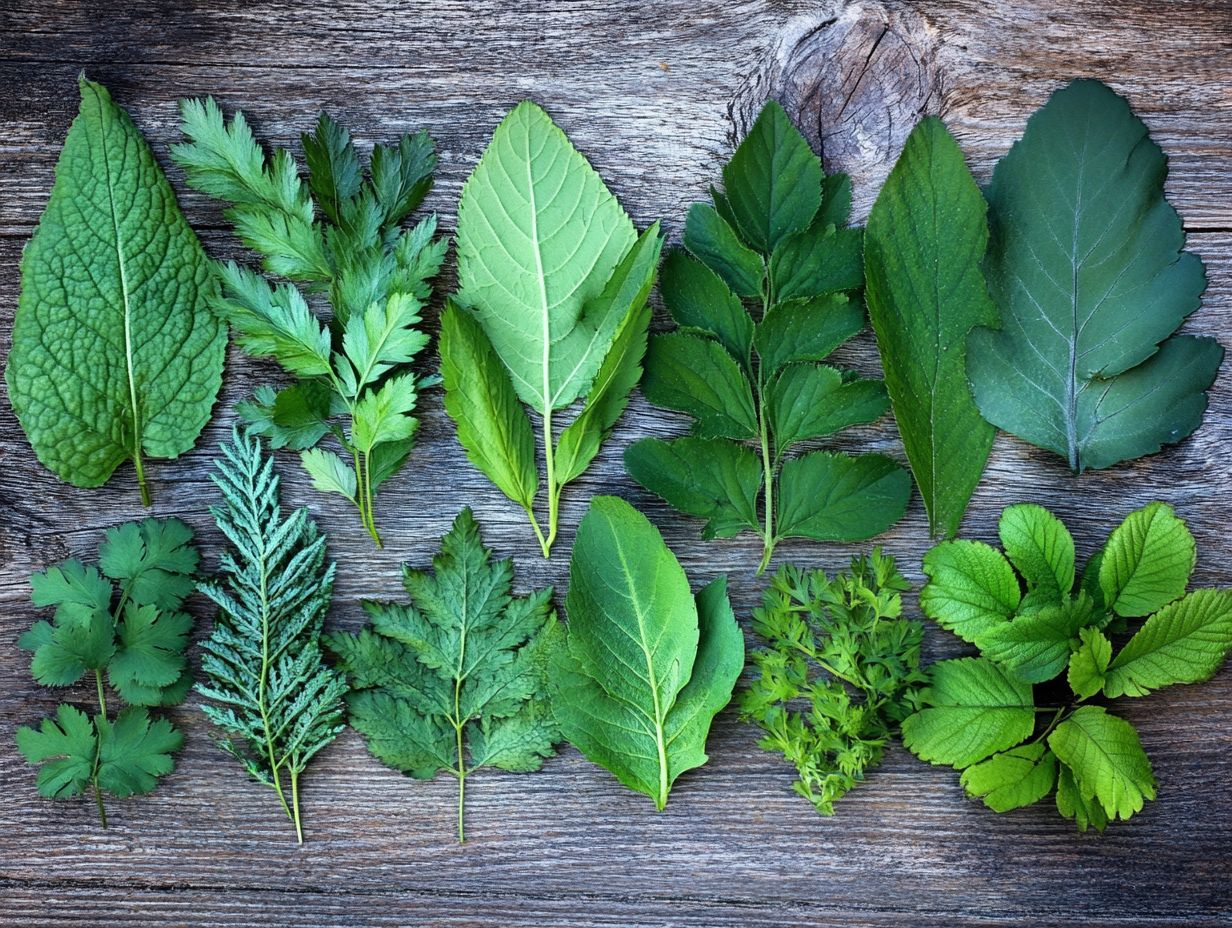
Wild edibles manifest in a remarkable array of forms, encompassing nutritious roots and delectable fruits that can elevate your diet. Take the wild potato and taro, for example; they are outstanding choices rich in essential nutrients. Then there are baobab fruits, which offer a treasure trove of vitamins. By mastering various cooking methods, you can expand the ways these wild edible plants enhance your culinary creations.
Dandelion greens add a delightful peppery flavor to the table and are loaded with vitamins A, C, and K ideal for tossing into salads or saut ing as a vibrant side dish. Don t overlook chickweed, often spotted in gardens; this wild green is nutrient-dense and can be enjoyed both raw and cooked.
Identifying these plants is straightforward: wild potatoes boast sturdy stems and broad leaves, while the unique star-shaped baobab fruit can be recognized by its hard shell. By adhering to proper foraging practices, you ensure sustainability and safety as you incorporate these wild delicacies into your kitchen.
Safety Considerations When Foraging for Wild Edibles
Safety is of utmost importance when you venture into foraging for wild edibles. Misidentifying plants can lead to dangerous consequences. Always double-check! Consuming poisonous varieties poses serious health risks.
A good identification guide is your best friend in foraging. It helps you recognize safe wild foods and discern the differences between edible species and their toxic counterparts. Furthermore, mastering proper harvesting and preparation techniques is essential to ensure that what you gather is both safe to eat and nutritionally beneficial.
Identifying Poisonous Plants
Identifying poisonous plants is a crucial skill for any forager. Many edible plants come with toxic doppelg ngers, or poisonous plants that resemble edible ones, that could ruin your day perhaps even your life. By using a reliable identification guide, you can learn to distinguish safe wild foods from potentially dangerous species, significantly reducing the risk of accidental poisoning. Familiarizing yourself with common poisonous plants, like certain ferns or wild tulips, is essential for safe foraging.
To effectively identify these hazardous species, pay attention to visual characteristics such as leaf shape, flower arrangement, and overall plant structure. For example, you can spot poison ivy by its distinctive clusters of three leaves, while water hemlock is identifiable by its intricate white flower clusters and hollow stems.
Being aware of seasonal changes in these plants is also vital, as some may not look toxic during different times of the year. To avoid any unfortunate encounters, it’s wise to steer clear of consuming plants you can’t confidently identify. Consider attending local foraging workshops or seeking expert consultations to sharpen your skills and enhance your foraging adventures.
Proper Harvesting and Preparation Techniques
Proper harvesting and preparation techniques are essential for ensuring that wild edibles are both safe and nutritious for your enjoyment. It s crucial for you to understand how to efficiently harvest these edible parts without causing harm to the plants. Equally important is knowing the best methods to prepare these foods, allowing you to enhance their flavors and unlock their nutritional benefits.
Take water plantain, for example; it flourishes in marshy areas and can be harvested by gently pulling the roots, allowing the plant to regenerate. With bamboo, timing is everything; young shoots should be gathered in the spring for that perfect tenderness. It s wise for you to familiarize yourself with local regulations on wild harvesting and engage in methodical identification to steer clear of toxic look-alikes.
Thoroughly washing and cooking these wild edibles not only elevates their taste but also neutralizes any harmful compounds, ensuring that your meals are both safe and nutritious.
Frequently Asked Questions
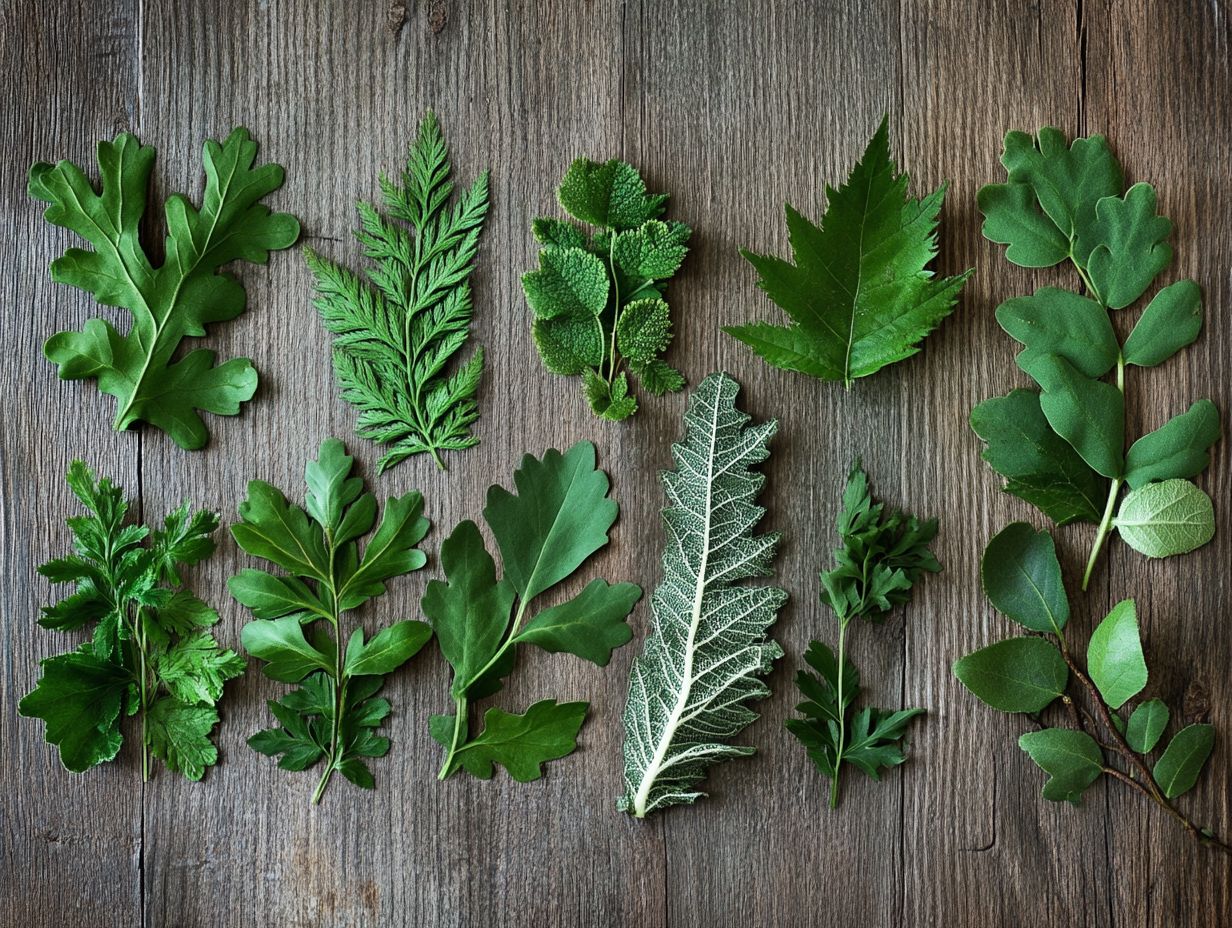
What is the purpose of a leaf shape guide for wild edibles?
A leaf shape guide helps you identify edible plants in the wild by focusing on their leaf characteristics, much like the insights found in wild edibles: a safe forager’s guide to identification.
How can I use a leaf shape guide to identify wild edibles?
By comparing the shape, size, and other features of a plant’s leaves with those in the guide, you can determine if it is safe to eat.
Are there any specific leaf shapes that are common among edible plants?
Yes, some leaf shapes are more common among edible plants. These include heart-shaped, oval, and lobed leaves. Always consult a guide to confirm your findings.
Can leaf shapes change or vary within the same plant species?
Yes, leaf shapes can vary within the same plant species due to factors such as age, growing conditions, and environmental influences. This is why it is important to use a comprehensive guide for accurate identification.
What are some common leaf shapes that are found in poisonous plants?
Some common leaf shapes found in poisonous plants include needle-shaped, compound, and feather-like leaves. Knowing these shapes is crucial! It helps you steer clear of toxic plants.
Is a leaf shape guide the only tool I need to properly identify wild edibles?
A leaf shape guide is just one tool for identifying plants. It is also vital to consider other characteristics such as color, texture, and smell. Don t rely solely on a leaf shape guide! Use it alongside other tools to ensure your safety.

